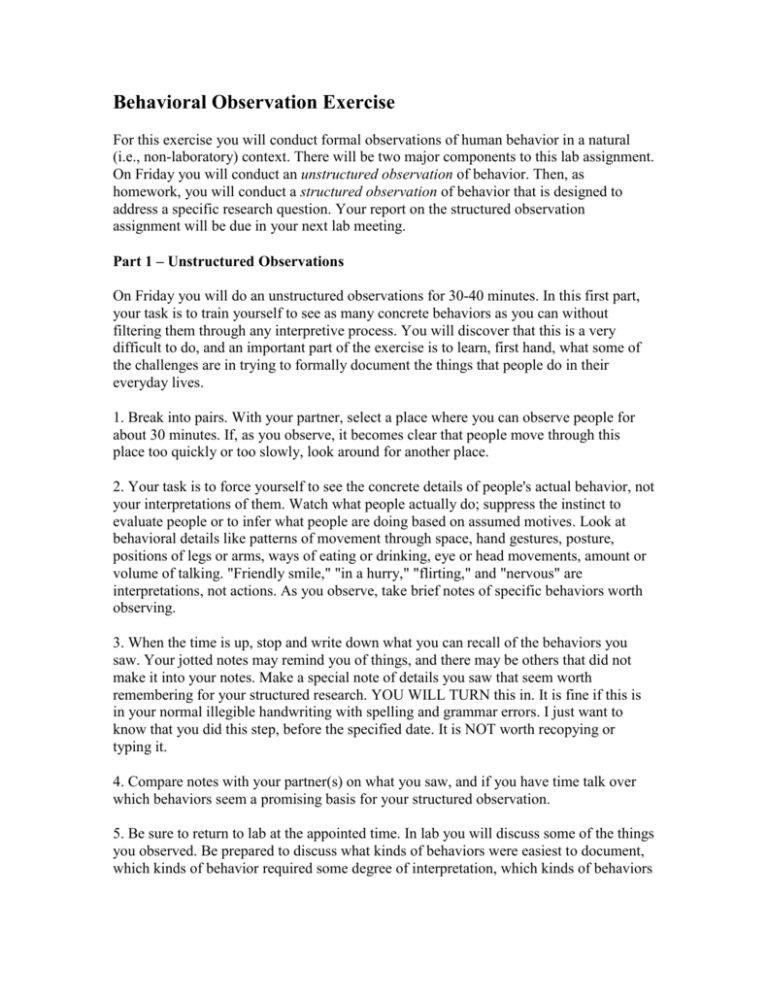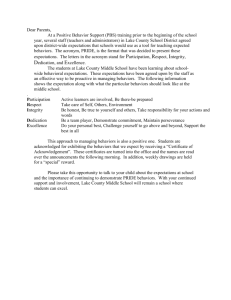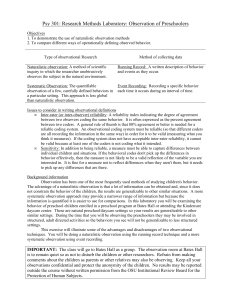Behavioral Observation Lab Assignment
advertisement

Behavioral Observation Exercise For this exercise you will conduct formal observations of human behavior in a natural (i.e., non-laboratory) context. There will be two major components to this lab assignment. On Friday you will conduct an unstructured observation of behavior. Then, as homework, you will conduct a structured observation of behavior that is designed to address a specific research question. Your report on the structured observation assignment will be due in your next lab meeting. Part 1 – Unstructured Observations On Friday you will do an unstructured observations for 30-40 minutes. In this first part, your task is to train yourself to see as many concrete behaviors as you can without filtering them through any interpretive process. You will discover that this is a very difficult to do, and an important part of the exercise is to learn, first hand, what some of the challenges are in trying to formally document the things that people do in their everyday lives. 1. Break into pairs. With your partner, select a place where you can observe people for about 30 minutes. If, as you observe, it becomes clear that people move through this place too quickly or too slowly, look around for another place. 2. Your task is to force yourself to see the concrete details of people's actual behavior, not your interpretations of them. Watch what people actually do; suppress the instinct to evaluate people or to infer what people are doing based on assumed motives. Look at behavioral details like patterns of movement through space, hand gestures, posture, positions of legs or arms, ways of eating or drinking, eye or head movements, amount or volume of talking. "Friendly smile," "in a hurry," "flirting," and "nervous" are interpretations, not actions. As you observe, take brief notes of specific behaviors worth observing. 3. When the time is up, stop and write down what you can recall of the behaviors you saw. Your jotted notes may remind you of things, and there may be others that did not make it into your notes. Make a special note of details you saw that seem worth remembering for your structured research. YOU WILL TURN this in. It is fine if this is in your normal illegible handwriting with spelling and grammar errors. I just want to know that you did this step, before the specified date. It is NOT worth recopying or typing it. 4. Compare notes with your partner(s) on what you saw, and if you have time talk over which behaviors seem a promising basis for your structured observation. 5. Be sure to return to lab at the appointed time. In lab you will discuss some of the things you observed. Be prepared to discuss what kinds of behaviors were easiest to document, which kinds of behavior required some degree of interpretation, which kinds of behaviors were best summarized via counting and which were best summarized by measuring duration. Structured Observation (homework due Friday– Sept 13th) In the second part of this assignment you will attempt to answer a specific research question via behavioral observations. In this exercise, you will be narrowly focused on a smaller number of behaviors rather than attempting to observe behavior more broadly. Watch the following video: http://www.youtube.com/watch?v=W_yHS_k32mU This video captures a conflict that takes place between spouses. Your goal is to answer the following two questions: (a) Which individual expresses more negative emotion? And (b) which individual exhibits more withdrawal behavior? To answer these questions well, you will need to develop a coding system for negative emotion and withdrawal behavior. Your assignment is to do the following: 1. Watch the video once. Based on the video, think of some ways you can go about coding these two forms of behavior. Think about whether you want to count things that happen, make note of things that do not, and/or whether you want to record the amount of time that the actors spend doing (or not doing) certain things. There are a lot of things to study; you need to think of something manageable and appropriate. Once you’ve developed your coding system, make it clear what you’re coding and the rules you’re using for doing so. 2. After you’ve developed your coding system, watch the video again and code the behavior of each member of the couple according to your system. Use timestamps (i.e., the time point in the movie) to record behaviors whenever appropriate (e.g., “1:42 she threw something at partner”) 3. Use your coded date to answer the questions above. 4. Please turn in a summary of your coding system and explain it in enough detail that another person could use it to code the video and end up with similar answers as you. In addition, turn in your actual codes (i.e., you results) and your conclusions about the question above.






